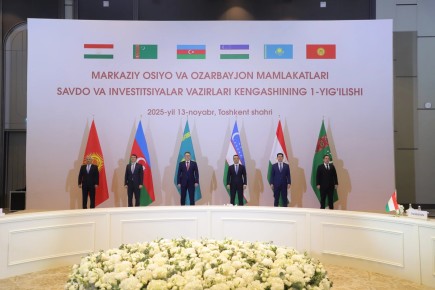According to the new edition of the World Bank's Economic Report for Europe and Central Asia, the economic growth in Uzbekistan is expected to rebound in 2021 as the country strengthens its pandemic management.
Health and social assistance costs have continued elevating the fiscal deficit. These pressures are mitigated by greater fiscal discipline and strong external buffers. The outlook for growth is favorable but contingent on improving global economic conditions and progress with structural reforms to increase private sector growth, reduce state dominance in the economy, and increase economic inclusion.
Key conditions and challenges
Reforms are beginning to address structural constraints such as absent factor markets and the state’s economic dominance. These reforms will create more room for competition and business growth and help create more jobs and incomes that help accelerate Uzbekistan’s market transition.
Job and income displacement from COVID -19 has amplified the importance of inclusion. About 9 percent of citizens live below the World Bank’s lower-middle-income poverty line ($3.2 a day, PPP 2011 adjusted); many more live close to this line. The national poverty level (based on minimum food intake) increased to 11.5 percent in 2020 from 11 percent in 2019. Expanded social assistance has provided some relief to Uzbekistan’s affected households, as has the swift recovery in employment following the economy’s reopening. Uzbekistan’s rebounding economy will support a return to poverty reduction in 2021. Over the medium-term, in addition to growth, faster poverty reduction will require stronger safety nets, labor market conditions, and health and education services.
Recent developments
GDP growth increased to 6.2 percent in H1 2021 after slowing to 1.7 percent in 2020. Strong industrial and services growth tempered weaker agricultural production. Robust increases in household incomes and domestic investment, and the continuation of anti-crisis spending and tax relief measures, also contributed to this year’s strong growth.
A decision to reduce gold export volumes led to a wider current account deficit of 10 percent of GDP in H1 2021 (from 7.3 percent in H1 2020). Exports of other goods, however, such as copper, textiles, fertilizers, food, and machinery, recovered from weaker trading partner demand in 2020. Total exports increased by 12.3 percent year-on-year. Imports grew by 14.3 percent in H1 2021 due to higher private consumption and a rebound in demand for capital goods. This led to a wider trade balance deficit of 18.8 percent of GDP in H1 2021 from 16.2 percent in H1 2020. Sustained inflows of personal remittances (8.7 percent of GDP in H1 2021) helped offset the negative trade balance.
The fiscal deficit was within budget at 5.4 percent of GDP in H1 2021. Lower policybased lending and higher tax revenues from a rebounding economy offset higher budget spending on social support, health, and public infrastructure. Though the deficit was financed through an increase in public debt, robust nominal GDP growth contributed to a slightly lower ratio of public debt to GDP of 38.5 percent of GDP in 1H 2021, compared with 38.9 percent at end-2020. The Government remains on track with its 2021 debt ceiling of $5.5 billion. Official reserves reached $34.1 billion in July 2021, an increase of $1.8 billion compared with July 2020.
Inflation has continued to trend lower, reaching 11 percent in June 2021 (compared with 14.7 percent in June 2020), but remained in double digits due to high food prices. Given an uncertain inflationary outlook, the central bank has left its reference interest rate unchanged since September 2020 at 14 percent. Credit growth in June 2021 slowed to 24 percent from 34 percent in June 2020, and 52 percent in 2019. This reflected weaker demand from higher real lending rates and a reduction in government-subsidized lending. The banking sector’s capital adequacy ratio fell to 17.4 percent in June 2021 from 18.5 percent in January 2021 and 20.8 percent in June 2020. This was partly due to a rise in nonperforming loans due to COVID-19, which increased to 4.6 percent in June 2021 from 2.2 percent in June 2020.
Nevertheless, Uzbekistan’s financial system remains sufficiently capitalized to absorb potential credit shocks. From August 1, 2021, to further reduce financial sector risks and dollarization, commercial banks will face increased reserve requirements on foreign currency bank deposits in banks from 14 to 18 percent.
Alongside a recovering economy, the unemployment rate declined to 10.2 percent in H1 2021 from 13.2 percent in H1 2020 and 10.5 percent at end-2020. The unemployment rate has not yet returned to pre-pandemic levels (of about 9 percent) and remains disproportionately high for women and youth.
Outlook
Growth is projected to accelerate to 6.2 percent in 2021. However, this forecast remains subject to uncertainties about the continued impact of further COVID-19 waves on global and domestic economic conditions. A recovery of investment, trade, and remittances will support the economic growth and reduce unemployment and poverty in 2021.
Growth is projected to remain strong at 5.6 percent in 2022 as the pace of vaccinations accelerates and global disruptions ease further. The current account deficit is projected to be 5.9 percent of GDP in 2021 as capital imports for investment projects recover and as gold exports fall from record levels in 2020. Foreign direct investment is expected to remain subdued in 2021 and partially recover in 2022. The continued expansion of social assistance and public investments to improve rural infrastructure, and vaccination costs, will continue to elevate public spending in 2021.
This will be partially offset by higher tax, mining, and privatization revenues, leading to a projected overall fiscal deficit of 5.5 percent of GDP in 2021. Increased public debt will finance this deficit, and public debt is projected to reach 40.6 percent of GDP by end-2021. COVID-19 uncertainties and a forthcoming VAT rates reduction in 2023, are likely to contribute to a higher medium-term fiscal deficit. A robust economic recovery, the gradual withdrawal of anti-crisis measures, and tax administration reforms to widen the tax base are projected to help consolidate public finances and stabilize debt at about 42 percent of GDP by end-2023.












